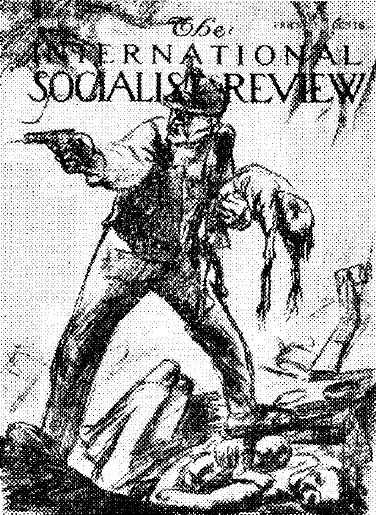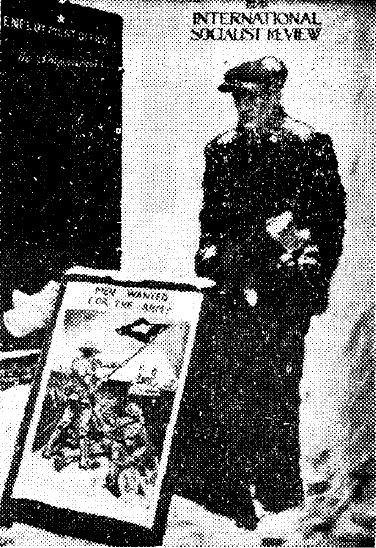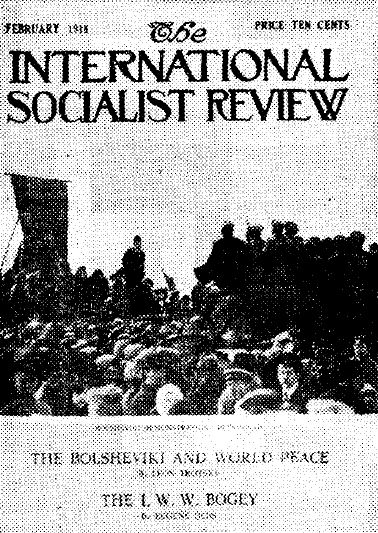Main ISR Index | Main Newspaper Index
Encyclopedia of Trotskyism | Marxists’ Internet Archive
International Socialist Review, Summer 1956
To Our Readers
From International Socialist Review, Vol.17 No.3, Summer 1956, pp.74, 105-106.
Transcription & mark-up by Einde O’Callaghan for ETOL.
With this issue we change our name from Fourth International to International Socialist Review. This does not signify a change in editorial policy. We shall continue as before to present the Trotskyist outlook on world events, emphasizing in particular questions involving Marxist theory. The new name, we hope, will help us to reach a broader audience among those beginning to appreciate the significance of the worldwide upsurge of socialism that has occurred since the end of World War II.
Our magazine was founded 22 years ago, in 1934. Its name then was The New International. This name corresponded with the main task of the international vanguard of the working class at that time; namely, to build a new international party of revolutionary socialism following the definitive collapse of the Third International as demonstrated by its permitting Hitler to come to power in Germany without a fight. The New International performed an historic role in combatting Stalinism and gathering together sufficient forces to launch a new worldwide organization based on the program of revolutionary socialism.
On the eve of World War II a minority section of the new movement succumbed to the war pressure. They put in question the defense of the Soviet Union itself when the counterrevolutionary Stalinist regime made an allianc’e with imperialist Germany. In the ensuing faction struggle, which centered mainly in the Socialist Workers Party, Leon Trotsky headed the majority defense of the Marxist position. Faced with defeat after a most thoroughgoing democratic discussion, the minority under the leadership of James Burnham and Max Shachtman decided to split. They also decided to take advantage of their technical position as editors of The New International and abscond with the magazine, changing its editorial policy to conform with their revisionist views.
Rather than squabble over this case of petty larceny, the majority decided to choose a new name for the magazine. Fourth International was selected as corresponding with the task of the time – to uphold the programmatic banners of the world movement created by Leon Trotsky.
During the difficult war years, when this movement was beset by every force of reaction extending from Nazism to Stalinism, Fourth International played a key role in defending what had been achieved and in preparing for the resurgence of the Trotskyist movement from the underground where all political protest had been driven by the dictatorial war machines.
In the post-war years, Fourth International was an invaluable auxiliary in consolidating the new forces that rallied on a world scale to the program of Trotskyism. With the post-war stabilization of the Trotskyist movement, however, the name of the magazine began to lose its timeliness. Many of its most loyal supporters felt that a change should be made, especially to widen its attractiveness to newly awakening layers of workers and student youth in America. However, we must admit we had some difficulty in reaching general agreement on a new name until the present choice was suggested, International Socialist Review. This was the name used by a magazine in the left wing of the socialist movement in this country before World War I. The tradition left by this magazine is a good one and has actually constituted a part of the heritage of American Trotskyism since the founding of our movement in 1928.
The International Socialist Review appeared in July 1900 and ran until February 1918, first under the editorship of A.M. Simons and then Charles H. Kerr. Its first editorial announced the basic policy to which it adhered throughout its 18-years’ existence. Pointing out that America had the most developed capitalism, yet the most primitive socialist movement, so far as theory is concerned, the first editorial declared:
“Socialism is but the philosophy of capitalist development and since it is an undisputed fact that American capitalism is further advanced and more clearly developed than that of any other nation, the American socialist may be pardoned if he believes that that should in time produce the most clear cut and developed socialism. At the very least he knows that illustrations drawn from American experience need be no less scientific and are much more effective for propaganda than those drawn from European experience.
“Under these circumstances it is felt that the time is now here when the American socialist movement needs and is able to maintain a magazine of scientific socialism and the International Socialist Review has been established to fill that need. It will at all times have three principal objects in view. In the first place we shall seek to counteract the sentimental Utopianism that has so long characterized the American movement and give it a dignity and accuracy worthy of the position it is destined to attain in the world wide advance toward the cooperative commonwealth. In the second place we shall endeavor to keep our readers in touch with the socialist movements in other Countries, and through the very able corps of foreign socialist writers and thinkers who have kindly agreed to contribute to this end, bring together each month the work and opinions of the best thought of the world on the philosophy of socialism. Finally, but perhaps most important of all, we shall aim to secure the interpretation of American social conditions in the light of socialist philosophy by the socialists of this country.”
Policy, said the editorial, “will be in accordance with the principles now universally accepted by the socialists of the world of independent political action by the laborers upon the basis of a struggle of classes with divergent material interests, with the ultimate object of securing the common ownership by such laborers of the means of production and distribution ...”
|
|
 |
|
|
The old International Socialist Review held to one main principle – the class struggle. The cover of the issue reporting the Ludlow massacre, depicting the heroic defense of the Colorado miners against the rifles of the Rockefeller interests, exemplifies the militant spirit that inspired the magazine. The artist was John Sloan.
|
The names of the writers in the early years of the magazine constitute a roster of the great figures in the Second International. Kautsky, Wilhelm Liebknecht, Bebel, Longuet, Parvus, Jaurès, Labriola, Pannekoek, and so on. An increasing number of American writers appeared, among them: Eugene V. Debs, Jack London, Gustavus Myers, Louis B. Boudin, Clarence Darrow, Carl Sandburg, David Karsner, Upton Sinclair, etc.
With the rise of the IWW movement, the magazine increased its coverage of the class struggle, at some expense it must be said, to its presentation of Marxist theory. A new galaxy of revolutionary figures appeared among its writers. William D. Haywood was listed on the editorial board. Vincent St. John became a contributor. The names of militants on the firing line began to show up – Elizabeth Gurley Flynn, C.E. Ruthenberg, Wm. Z. Foster, Thomas J. Mooney, and so on. In the Nov. 1912 issue a report on The Seventh IWW Convention was signed by J.P. Cannon. Louis C. Fraina and John Reed were added to the list of regular contributors.
In the struggle of the left wing against opportunist tendencies in the Socialist Party, a struggle that grew sharper from 1911 to 1914, the International Socialist Review was decidedly with the left wing and against the opportunists.
|
|
 |
|
|
The problem of unemployment was a recurrent theme in this fighting magazine. The cover of the December 1914 issue, done in a striking red and black, voices the bitter protest felt among advanced workers at the kind of employment the outbreak of World War I foreshadowed.
|
The outbreak of war in 1914 confronted the whole international socialist movement with an ideological crisis of the gravest character. The leaders of the Second International, especially those in Germany who were considered the teachers, the living link with Marx and Engels, capitulated to the bourgeoisie. They supported the imperialist war.
The shock that was felt by the rank and file socialists throughout the world is only comparable to the shock experienced by rank and file members of the Communist Parties today on discovering that Stalin was really a mass murderer. How to explain it?
The International Socialist Review courageously began to probe the reasons – and began to find them in deviations from Marxist principles that had begun years before. In place of agitation, of stress on action in the class struggle, the interest of the magazine definitely shifted to theory. The change in emphasis was reflected by longer, more profound articles and new names – Karl Liebknecht, Rosa Luxemburg, Franz Mehring. And the left-wing forces they represented in Germany gave the magazine new hope after the great betrayal of 1914.
The May 1916 issue hailed the Zimmerwald conference as the beginning of a new international to replace the dead Second International, but criticized the compromises that were reached there, stating that the real hope lay with the left wing at that gathering and with the program enunciated in their resolutions.
Not until January 1918 do the names of Lenin and Trotsky show up – but then they at once dominate the magazine. In the February issue the lead article is a reprint of the preface to Trotsky’s The Bolsheviki and World Peace. An editorial note reflects the enthusiasm of the magazine over the Russian solution to the great ideological crisis that had haunted the socialist movement for four years:
“Comrade Trotsky was preparing an article for the Review when the revolution came in Russia, compelling him to drop everything and return. Review readers will appreciate our disappointment and later on our joy in reading the inspiring record our comrade has made during the past few months.”
And they recommend the book written by the new Russian Minister of Foreign Affairs who, only a few months before, had been a refugee in New York:
“Every revolutionary socialist in America will want to read and reread his new book entitled The Bolsheviki and World Peace.”
That was enough for the Woodrow Wilson administration in Washington. The postal authorities barred the magazine from the mails and it was forced to cease publication.
|
|
 |
|
|
This is the cover of the final issue. The main article, by Leon Trotsky, explaining the opposition, of the Bolsheviks to imperialist war and their program for achieving enduring peace, was answered by an official order from Washington banning the magazine from the mails.
|
The International Socialist Review was a colorful magazine filled with photographs of strikes, demonstrations and events of the class struggle. It carried photographs of socialists in action, from leaders like Debs and Haywood to outstanding rank and filers like Thomas J. Mooney, who first began making a name for himself selling socialist literature. If it analyzed a new development such as the appearance of automatic machinery in the auto industry or in bottle-making, it carried pictures of the fabulous new machines along with figures on the number of workers they displaced.
It made room for illustrators and cartoonists and its covers featured drawings, photographs, and colored layouts that would be outstanding on the magazine stands today.
Our limited financial resources do not permit us as yet to come near the old International Socialist Review in the use of colors, drawings or photographs or in on-the-spot reporting of the class struggle, but we do think we can continue its tradition of militancy and of concern about theory and perhaps help bring nearer the prognosis of its first issue way back in 1900 that American capitalism “should in time produce the most clear cut and developed socialism.”
Top of page
Main ISR Index | Main Newspaper Index
Encyclopedia of Trotskyism | Marxists’ Internet Archive
Last updated on: 21. April 2009


